For most guys…men need a suit & tie.
It's powerful.
It displays high status.
It builds up confidence.
But…some of them also have tunnel vision.
They zoom in on the upper body clothing – their jacket, necktie, watch, etc.
And overlook the details down below:
Their dress shoes.
They either throw on an old pair – or wear the wrong shoes.
But if your goal is to be more credible, well-respected, and listened to…
You must sharp from head to toe.
And that entails wearing shoes that both:
- Enhance your wardrobe
- Fit the occasion well
Formal Vs Casual Shoes: 1st Ranking Factor – Shoelaces
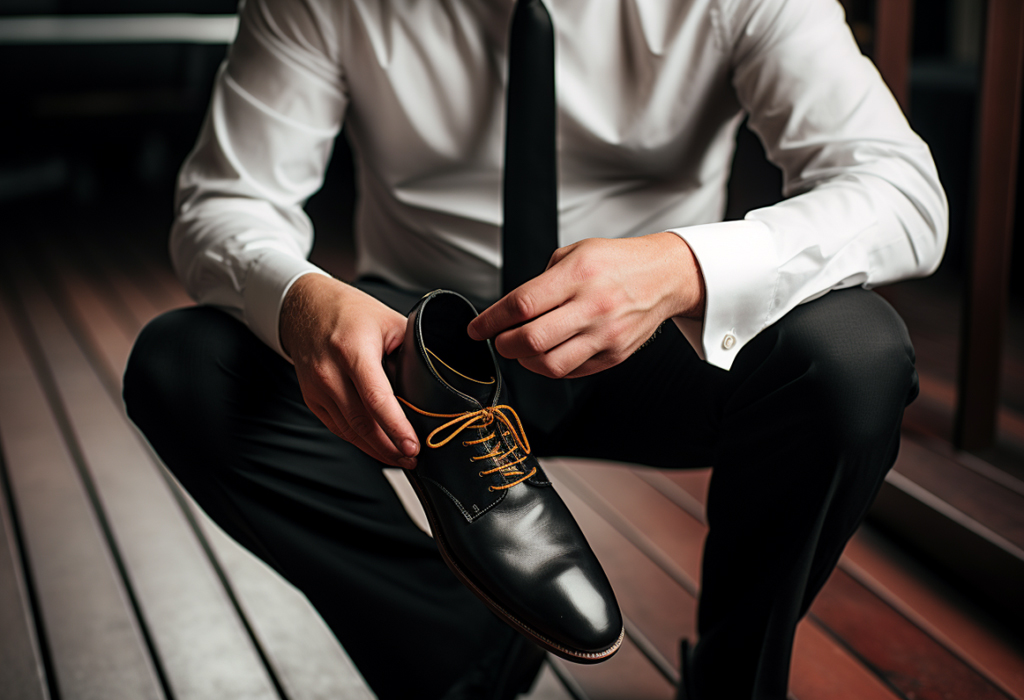
One basic way of sorting out the “more formal” and “more casual” shoes is by the presence of shoelaces. History shows they've practically been around since people decided to craft materials to cover their feet.
Although historians don't have a clear breakdown on the history of shoelaces (or shoes for that matter) they give an estimate based on ancient recordings that shoelaces were invented around 3000 BC. So that's a pretty long time!
They were most likely invented out of people's need to fasten whatever piece of footwear was created to their feet. If the shoes were leaf-based, they wouldn’t remain in the bottom of one's feet without being tied on. So there's a chance that the shoelaces used back then could've been strands of grass or natural string sources.
There's also the discovery of the ancient Areni-1 shoe (which is said to date back to 3500 BC) where proof of advanced lacing technology could be found. It actually had leather shoelaces designed to pass through slotted eyelets – which had been cut into the animal hide material.
Formal Vs Casual Shoes: 2nd Ranking Factor – Amount Of Detail

The general rule of formal wear is that less (simpler) is more. That's why the most formal dress shoes aren't supposed to look “busy” or filled with interesting, intricate detail.
If you're aiming to steer clear from the casual side, it's not just about meeting the shoelaces requirement. The toe (the section where your toes are located right below) should be a:
1. Plain Toe – where the vamps are non-decorated and the look is distinctly clean
2. Cap Toe – where a horizontally stitched line goes across each vamp to “cap” the toe
More Broguing = More Casual
Certain dress shoes set themselves apart from the pack when it comes to broguing – the amount of decorative perforation. Perforations were originally invented centuries ago by men who wanted to let water escape the shoes more easily while treading across marshes. Now they're solely for display or fashion (not so appropriate for conservative settings or business events).
Formal Vs Casual Shoes: 3rd Ranking Factor – Color
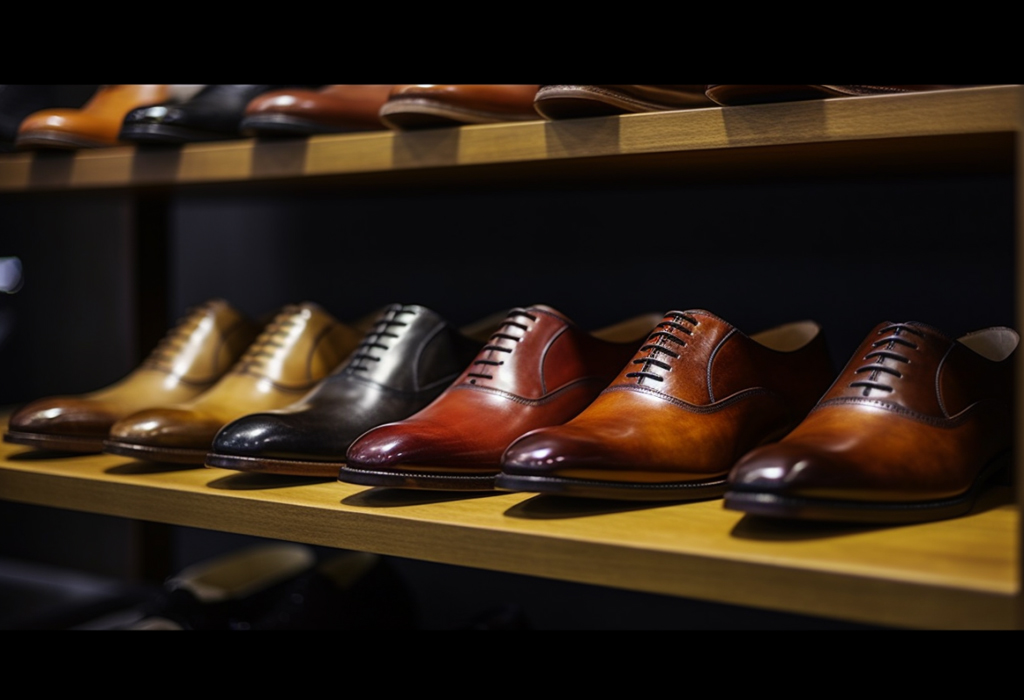
Black is hands down the color that outranks the rest. It brings out class, sophistication, and even a level of mystery to your wardrobe. It's also associated with more power and authority – which helps explain why most tuxedos, priestly garments, and judges' robes come in black.
But which one's the runner up? That title goes to brown – particularly darker shades of brown (including derivatives of red like oxblood and burgundy). You can do some reading on black vs. brown dress shoes and hear varying opinions. But do remember that light browns and all other possible shoe colors are far more casual.
These are the questions to ask yourself when you're torn in choosing a shoe color:
- How formal is the occasion? Is it an all-business affair or a date/social gathering?
- Are you attending a non-formal event in the daytime or evening? Light-colored dress shoes are more welcome during the day while darker colors look better in the evening.
- Is it summertime or a warm day? People are more inclined to wear and appreciate lighter colors in warmer temperatures.
Bonus Factor: Material of the Sole – Leather Vs Rubber
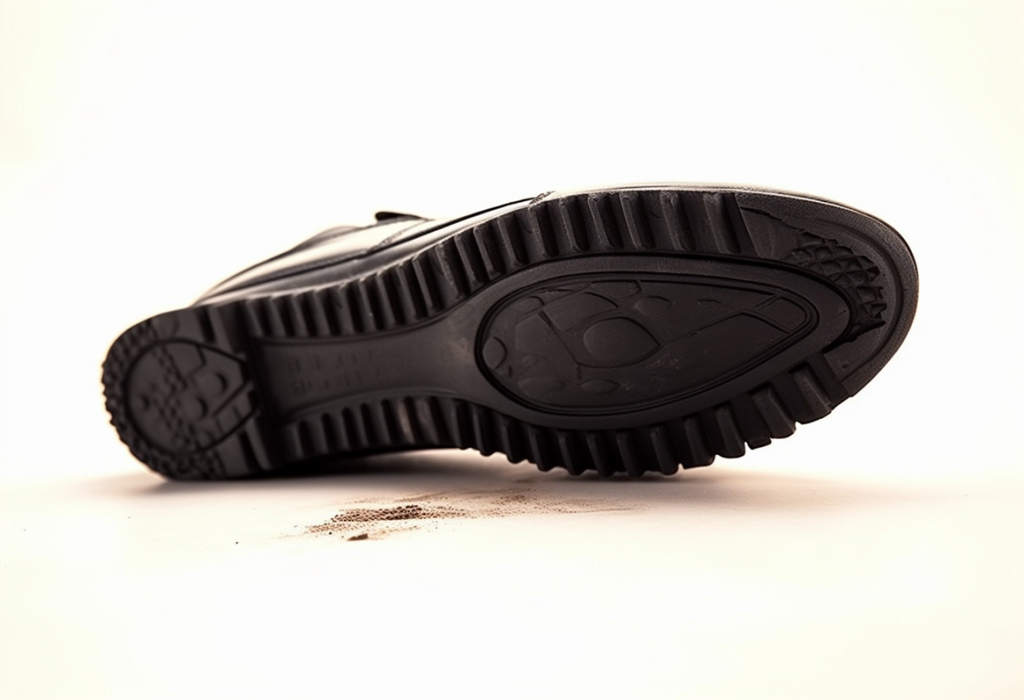
The bottommost part of the shoes also has a say in how formal they turn out to be. So here's a comparison between leather and rubber soles.
Leather
- Leather is more formal than rubber in general – but requires a correctly done cut if you want it to stay very elegant.
- The material has a better quality and more strength, especially if it's made up of multiple layers of leather (a triple-leather sole can outlast any rubber sole).
- The problem is if the leather isn't properly done – it can have a rigid structure which can be comfortable to the foot. Shoes are best made on a last with ample arch support.
Rubber
- Rubber lacks the formality of a leather sole due to its natural “chunky” appearance.
- The material offers more flexibility with a minimal break-in period. It also naturally has more shock absorption than leather so you can walk with it on rougher pavements.
Types Of Dress Shoes Ranked (Formal To Casual)

Types Of Dress Shoes #1 – Plain Black Oxfords & Balmorals

Oxfords are closed-laced dress shoes. The vamps are sewn on top of the quarters (back part containing the lacing flaps). Both parts stick together more closely – which provides a sleek look and smooth-looking silhouette to the shoes. Meanwhile, Balmorals are named after the Balmoral Castle located in Scotland. They're basically Oxfords without any seams.
And then we have shoes made of patent leather (a coated kind of leather with a distinctly glossy finish). It can look like fake plastic – but it's the reflective shine that carries these shoes to the top of the list. You'll find patent leather in specialized shoes such as military dress shoes and formal pumps.
That brings us to Black Tie Formal Pumps (also called Court Shoes). Their origins trace back to the 18th century and these days, their look hasn't changed much. You'll see formal pumps designed with a silk/grosgrain bow that's flat or pinched. They're commonly part of dancers' attire and often quilted to provide some extra comfort.
Types Of Dress Shoes #2 – Oxfords & Balmorals with a Cap Toe
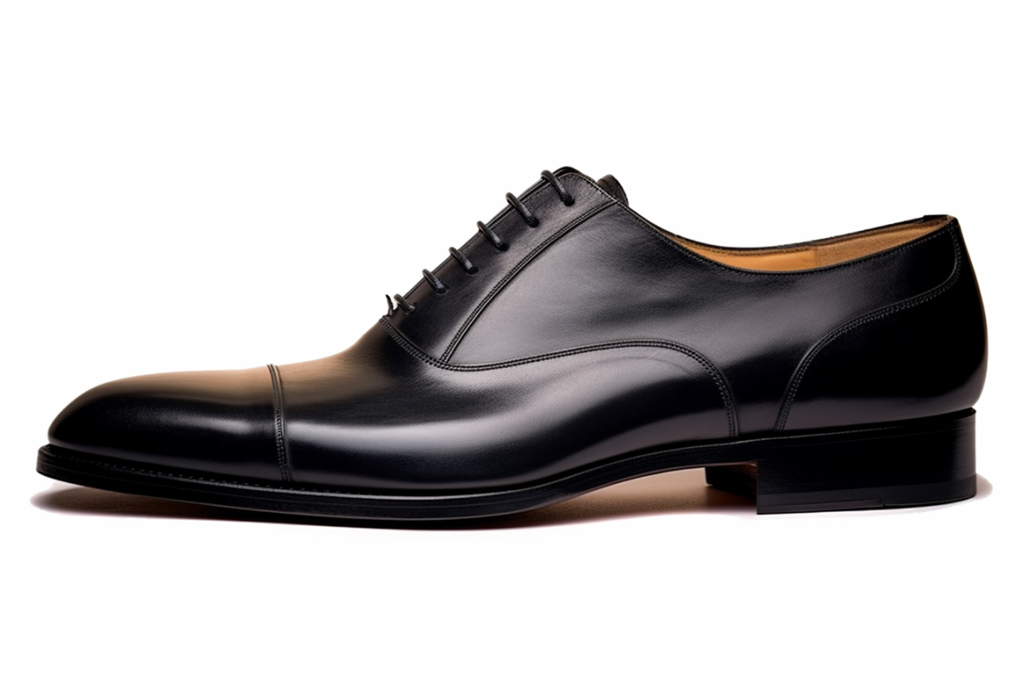
We've made it clear that black is the most formal color. That means Oxfords and Balmorals with an oxblood or dark brown tone have to occupy the 2nd spot. But at the same time, a black version of these shoes can lose a teensy bit of formality if there's a cap toe.
We can debate on how insignificant that horizontal lining at the toe really is – but that's what happens when we're sorting out dress shoes. Everything is taken into account.
Types Of Dress Shoes #3 – Wholecut Oxfords
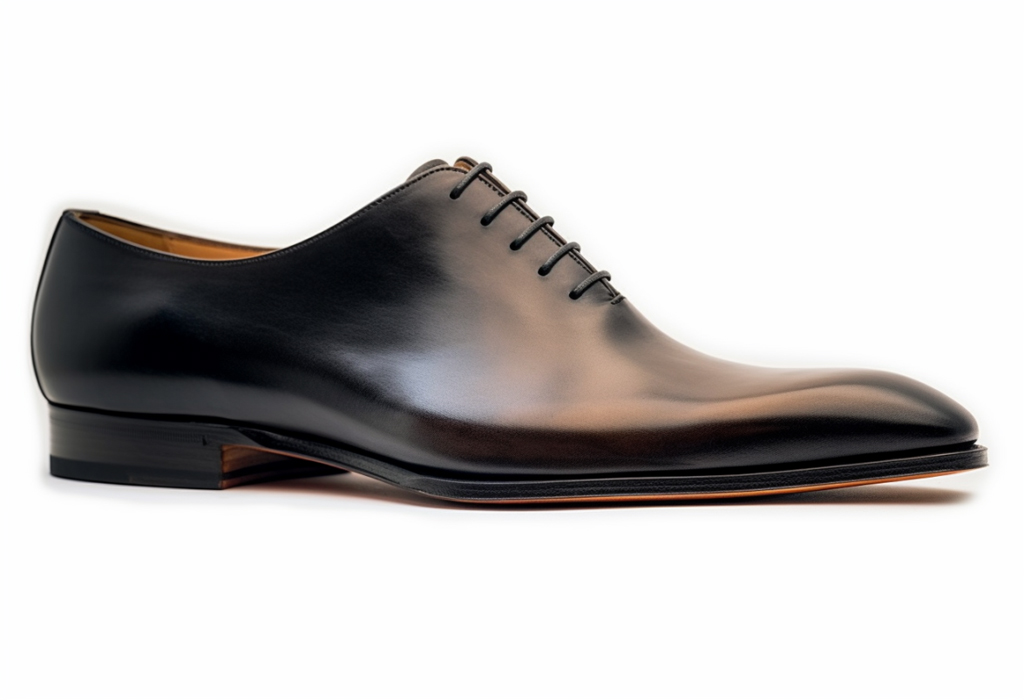
Regarding the term Wholecuts, it actually describes dress shoes that were cut from a single piece of leather – giving them a very tidy appearance.
Take note that there's an exception to the “less is more” rule that applies here. Although wholecuts have a simpler appearance – they're lower in the ranking than Oxfords and Balmorals with a cap toe or non-black color. And that's because of their non-traditional shoe construction.
Types Of Dress Shoes #4 – Derbys & Bluchers
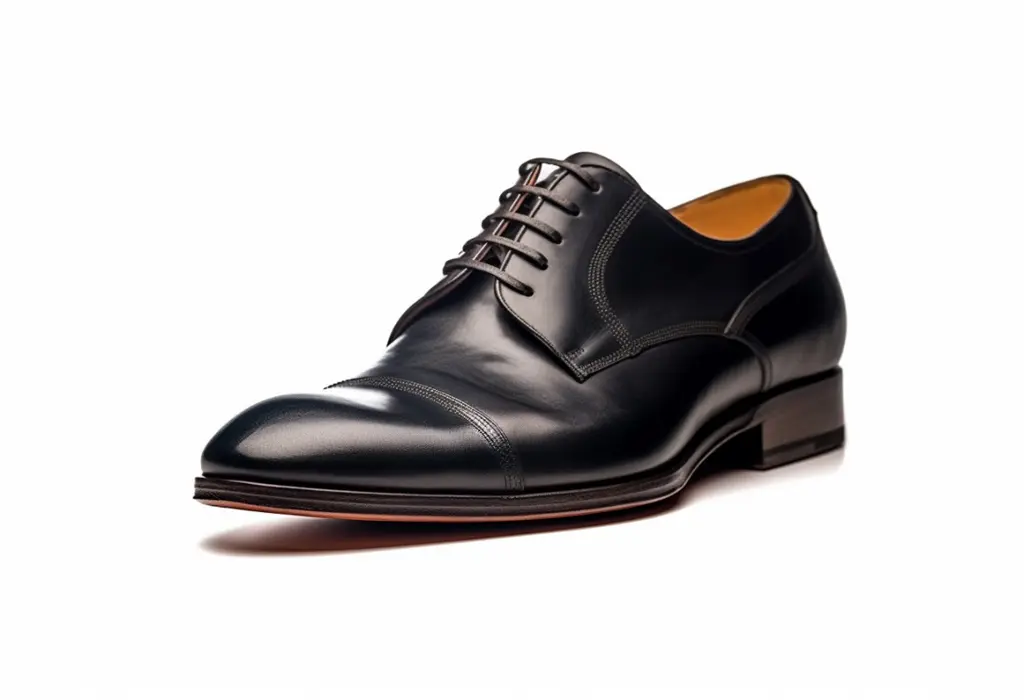
In contrast to the ones listed above, Derbys are open-laced dress shoes. They're constructed in the opposite manner – the quarters are sewn on top of the vamps.
The key difference is that the lacing flaps are not conjoined at the bottom. They have to be joined together by the shoelaces and this often leads to a small gap between them when the laces are tied. So open lacing causes some interruption in the shoes' silhouette – making them slightly less sleek and formal overall.
Bluchers are pretty much like Derbys. Except they have a few patches of leather on top of the vamps known as eyelet tabs (where the shoelaces pass through for tying). They're not as typical-looking as Derbys – slightly more unique. But in the U.S., the term Blucher and Derby are pretty much used interchangeably.
You can actually “level-up” your Derby or Blucher shoes by learning how to do straight bar lacing. This technique will keep the tongue of your dress shoes clean and aesthetically pleasing. And when your friends or colleagues notice that – you'll get compliments and a ego boost!
Types Of Dress Shoes #5 – Brogues

For this category – the dress shoes can be technically Oxfords, Bluchers or Derbys. But it's the perforations (originally found on shoes used for walking through wet terrain) which dominate the technical shoe type. So they lie in the middle of the pack.
The rule of thumb is the more broguing your dress shoes have, the less formal they are. There are 4 sub-types of brogues in total:
- Quarter Brogues – only the toe cap seam is lined with perforations
- Semi Brogues – there's broguing along the toe cap seam and on the top of the toe cap leather (but nowhere further up the shoe)
- Wingtips – the “wings” stop before the heels, with the heel caps still outlined and visible
- Longwing Brogues – the “wings” reach all the way to the back of the shoes
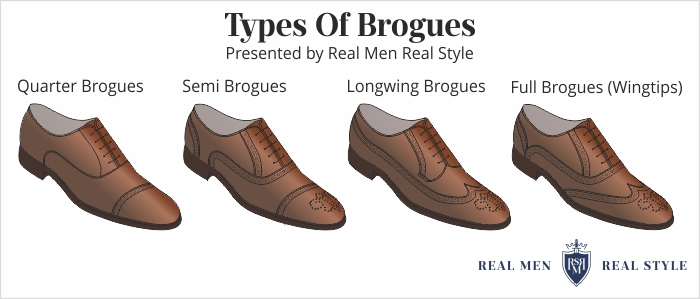
As the infographic above shows, Wingtips and Longwing Brogues are the most decorated and least formal brogues. They have broguing both along the seams and on top of the toes. Another key piece of detail lies in their uniquely shaped front sections – where the standard toe cap lining has turned into either a ‘W’, ‘M’ or ‘U’ shape.
Types Of Dress Shoes #6 – Chelsea Boots

Chelsea boots are notable for their flexibility – both in terms of function and style. They're laceless and designed with elasticated side panels that allow you to easily slide them on and off. All you have to do is pull a loop of fabric at the back.
What's great is the fact that – even if they're more casual and ranked 6th – you can still wear them (especially black ones) to certain semi-formal settings. Queen Victoria loved wearing them often back in the day.
And if you ever feel like going more vintage in your next party or social event, don't forget that the Beatles made Chelsea boots part of their signature style. Some versions are made of suede as well so they'd complement a suede jacket.
Types Of Dress Shoes #7 – Monk Straps
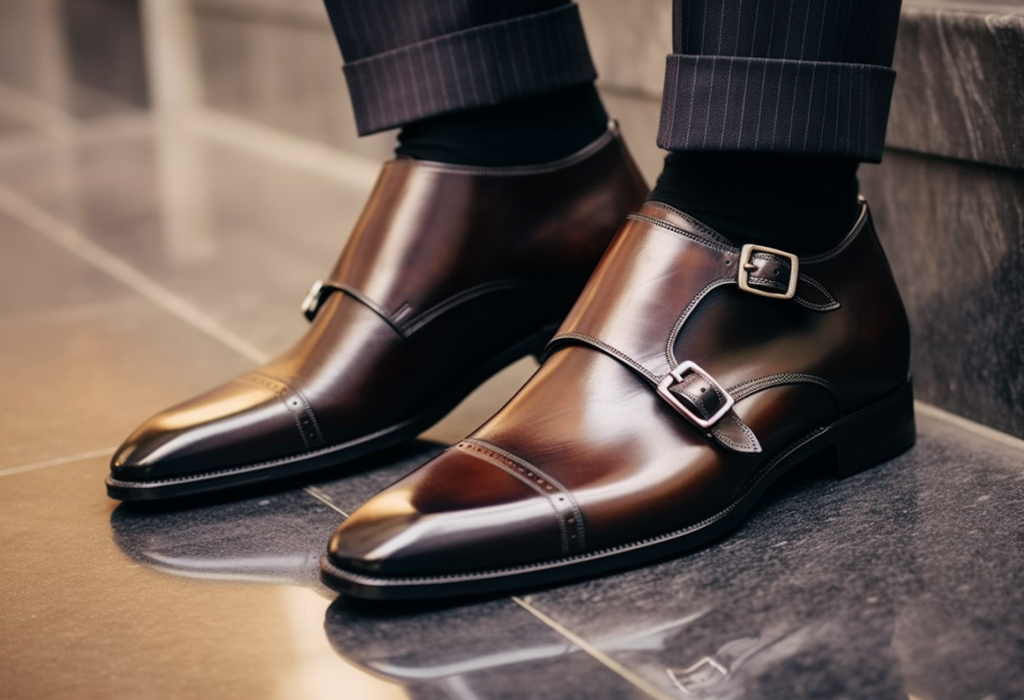
Up next are the elegant, fashion-forward version of Velcro sneakers. Like Chelsea boots, monk straps put a relatively modern spin on footwear and replace shoelaces with straps.
There are 2 main sub-types: Single and Double Monk Straps. The difference is one additional strap on each shoe – but single monk straps are technically the more formal kind due to the fewer details.
But whichever one you pick, see if you can match the buckles on the straps with other metals you'll be wearing (such as your watch or belt buckle). Coordination does wonders for your outfit.
Types Of Dress Shoes #8 – Loafers
Now we have Loafers – slip-on shoes without shoelaces or any form of fastening. They're made with low heels, separate soles, and often vamps which have a moccasin-like construction.
Penny Loafer

There are four main sub-types of loafers, each with its own decorative element:
- The most formal would be Gucci Loafers (where each shoe is decorated with a metal “horsebit”)
- Tied for second place would be Penny Loafers (with straps that have a diamond cut-out which was originally used for keeping pennies) and Belgian Loafers (slipper-like loafers with a small bow on each shoe)
- The least formal would be Tassel Loafers (where each shoe is ornamented with a leather tassel)
However, bear in mind that you can never look too “dressed down” while wearing loafers or any other dress shoe type. Leather footwear has been a status symbol for men throughout history.
Types Of Dress Shoes #9 – Dress Boots

Other dress boots aside from Chelsea boots take up the 9th spot. They might be more useful than dress shoes outdoors when it's raining or snowing – but not as useful for a fancy dinner party indoors.
So why are dress boots geared more toward casual? For starters, they cover you up more than shoes. More leather is used and they naturally pop out more from your clothing.
And there's that level of masculinity they bring out. The most “manly” kinds – military-inspired boots – became a trend during the reign of Charles I. With wars and political conflicts at their peak, people would wear such boots to reflect the serious times.
Types Of Dress Shoes #10 – Moccasins & Driving Shoes

Last but not least are the heelless shoes we're all too familiar with. Most moccasins sold in stores differ mainly by the sole:
Hard Sole Moccasins are typically made of tough bison leather (originally for protecting the feet of American Indians living in areas with sharp rocks, harsh cactus, and prairie-grass). Many also have a turned-up toe that prevents sharp objects from running into the seams.
Soft Sole Moccasins have a sole that's brought up the sides of the foot and over the toes – and then connected to a U-shaped piece lying on top of the foot. These shoes often have some beads or embroidery.
A more modern version of moccasins comes in the form of Driving Shoes – made of either suede or leather and with rubber-grommet soles. Indeed, they were first invented for men driving Italian automobiles who wanted an extra grip on their shoes. Now they're not just exclusive to drivers of stylish cars. They can be used by any stylish man (especially while wearing chinos, slim jeans or cotton shorts). Use them to spice up your casual outfit for the next movie date or night out with friends.
Types Of Dress Shoes Bonus: Two-Tone Wingtips (Spectator Shoes)

Spectators are known for comprising two colors (almost any combo would work). The contrast between the colors can either be very bold or just subtle. But the majority of these shoes do use either a white/black or white/brown combo.
What else you should know about spectator shoes:
- They're also brogues – except they're meant to be more casual than standard brogues or wingtips because of having two tones.
- They can be of two different textures too (such as suede paired with patent leather).
- They're a throwback to the Golden Age of men’s style in the early 1900s (and were made popular by musicians and prominent figures like the Duke of Windsor).
- They're perfect for casual weekends out in public, weddings or garden parties where you're dressed in a sports jacket and solid trousers.
Read next: 10 essential shoes every man should own.
The post 10 Types Of Dress Shoes Ranked From Formal To Casual appeared first on Real Men Real Style.
0 Commentaires